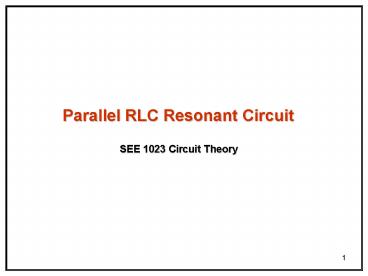SEE 1023 Circuit Theory - PowerPoint PPT Presentation
1 / 19
Title:
SEE 1023 Circuit Theory
Description:
Parallel RLC Resonant Circuit SEE 1023 Circuit Theory Parallel RLC Resonant Circuit Excitation (Input) Response (Output) Parallel RLC Circuit Constant input current ... – PowerPoint PPT presentation
Number of Views:136
Avg rating:3.0/5.0
Title: SEE 1023 Circuit Theory
1
Parallel RLC Resonant Circuit
SEE 1023 Circuit Theory
2
Parallel RLC Resonant Circuit
Parallel RLC Circuit
Response (Output)
Excitation (Input)
Constant input current Is Variable Source
angular frequency w
Main response Voltage
Other responses Power, Admittance, susceptance,
etc.
The parallel Resonant is the dual of the series
resonant.
3
Parallel RLC Resonant Circuit
Duality between series and parallel
Series Parallel
Voltage, V Current, I
Impedance, Z Admittance, Y
Reactance, X Susceptance, B
Resistance, R Conductance, G
Short-circuit Open-circuit
Capacitor, C Inductor, L
Inductor, L Capacitor, C
4
Parallel RLC Resonant Circuit
5
Frequency Response of The Voltage
(Variation of the voltage with frequency)
At Resonance, the voltage is maximum
6
Frequency Response of The Admittance
(Variation of the Admittance with frequency)
At Resonance, the admittance is minimum
7
Frequency Response of The Susceptance
(Variation of the susceptance with frequency)
At Resonance, the susceptance is zero
8
Frequency Response of The Power
(Variation of the power with frequency)
At Resonance, the power is maximum
9
Frequency Response of The Power
Three main points on the power plot.
At resonance, the power is maximum
10
Analysis of Parallel RLC resonant circuit
Three main points on the power plot
Point-0
(Po, wo)
Point-1
(0.5Po, w1)
Point-2
(0.5Po, w2)
wo angular resonant frequency
w1 and w2 half-power angular frequencies
w1 lower half-power angular frequency
w2 upper half-power angular frequency
11
The Current Phasor Diagram at wo
For R IR is in phase with V For L IL lags V by
90? For C IC leads V by 90? For parallel
circuit, use V as the reference because V is
common For all three elements.
IC
at wo
IR Is
V
The circuit is purely resistive.
IL
12
The Current Phasor Diagram at w2
For R IR is in phase with V For L IL lags V by
90? For C IC leads V by 90? For parallel
circuit, use V as the reference because V is
common For all three elements.
IC
ILICIRIS
ILIC
at w2
IR
V
IL
The circuit is predominantly capacitive.
13
The Current Phasor Diagram at w1
For R IR is in phase with V For L IL lags V by
90? For C IC leads V by 90? For parallel
circuit, use V as the reference because V is
common For all three elements.
The circuit is predominantly inductive.
IC
IR
V
at w1
ILIC
IRILIC IS
IL
14
Learning Sheet 3a
Five Resonant Parameters
1. Resonant Angular frequency,
2. Lower cut-off angular frequency,
3. Upper cut-off angular frequency,
4. Bandwidth of the resonant circuit,
5. Quality factor of the resonant circuit,
15
Learning Sheet 3a
Five Resonant Parameters
1. Resonant Angular frequency,
2. Lower cut-off angular frequency,
3. Upper cut-off angular frequency,
4. Bandwidth of the resonant circuit,
5. Quality factor of the resonant circuit,
16
Example Parallel RLC Resonant Circuit
Is 0.1 Arms, R 1k W, L 100 mH, C 10 mF
17
(No Transcript)
18
- (xi) The admittance of the circuit at w2 in polar
form
(xii) The voltage at w2 in polar form
(xiii) The real power P at w2
(xiv) The expression for v(t) at w2
(xv) The expressions for iL(t), iC(t) and
iL(t)iC(t) at w2
(xvi) Draw the current phasor diagram at
wo (xvii) Draw the current phasor diagram at
w1 (xviii) Draw the current phasor diagram at
w2 (ixx) Draw the waveforms of iC(t), iL(t) and
iC(t)iL(t) at wo (xx) Draw the waveforms of
iC(t), iL(t) and iC(t)iL(t) at w1 (xxi) Draw the
waveforms of iL(t), iC(t) and iL(t)iC(t) at w2
19
(xxii) The resonant frequency, fo (xxiii) The
lower cut-off frequency, f1 (xxiv) The upper
cut-off frequency, f2 (xxv) The bandwidth, BW in
Hertz (xxvi) The Quality factor, Q































